No edit summary |
No edit summary |
||
| Line 73: | Line 73: | ||
=Fixing or Replacing Leaky Air Ducts= |
=Fixing or Replacing Leaky Air Ducts= |
||
| + | |||
| + | [[File:Duct_Testing.jpg|thumb|left|300px|Duct Testing]] |
||
| + | |||
| + | This should be a big area of focus for older houses with forced air heating and/or cooling. The problem is, that over time, the duct system that carries the hot or cool air develops leaks and becomes inefficient. Since the ducts typically run through the attic, or in the basement or under-house crawl space, the leaks mean heat or cool is lost to non-living spaces. With an older house or in a house where ducts could have been damaged, leakage could range up to 50% or more which is a huge loss of energy efficiency and money waste. |
||
| + | |||
| + | Unfortunately, it is not easy to determine your self if you have leaky ducts. The only way to be sure is to hire a professional heating/cooling expert that is setup with the equipment to do a thorough duct test. To do this, all of the vents where heating or cooling enters your living spaces are blocked (with tape or temporarily installed coverings) and then a blower is applied to the ducts to pressurize the duct system and then leakage is measured with a professional tool. |
||
| + | |||
| + | If it is determined that your ducts are leaky, they can either be fixed by replacing sections or sealing them with spray-on sealant or the duct system could be completely replaced. |
||
[[Category:Sustainable living]] |
[[Category:Sustainable living]] |
||
Revision as of 19:34, 29 March 2012
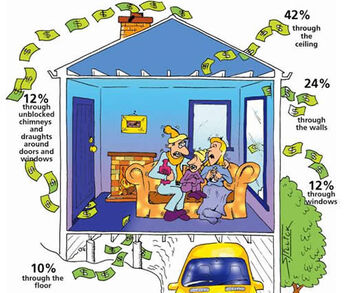
Energy Efficient House
There are many ways to make your house more energy efficient and save money in the process.
They include:
- Upgrading Attic Insulation
- Energy Efficient Window Film
- Fixing or Replacing Leaky Air Ducts
- Energy Efficient Furnace or Air Conditioning
- Finding & Fixing Air or Thermal Leaks
- Energy Efficient Lighting
This article will explore the options to address energy efficiencies in these areas.
Attic Insulation
Reducing house heat or cooling loss through the attic can we one of the best things to focus on to make your house more energy efficient -- especially if it is an older house. There are a number of options to consider here.
Fiber Insulation
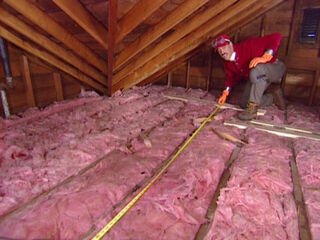
Fiber Insulation
Fiber insulation is typically blown into the attic or laid down in rolled sections called batts. Fiber can be made out of fiberglass, cellulose, mineral wool or sheep's wool. Fiber insulation in the attic is placed between and on top of the rafters. It reduces energy loss by stopping heat or cool from escaping from your living areas into the attic.
Each of these materials have "R" values which represents the materials resistance to heat flow. The higher the R value, the better the insulation of that material and, in general, the more expensive the material is. The amount of insulation or R-value you'll need depends on your climate, type of heating and cooling system, and the section of the house you plan to insulate.
Here's a good link to determine how much insulation to add to a new or existing house: Insulation Calculator
Rolled in insulation can be a fairly easy do-it-yourself project, but blown in insulation is almost often a professional job.
Blown in insulation has an additional advantage over rolled in insulation as it doesn't leave gaps in which heat or cool can escape.
Spray-In Foam Sealing
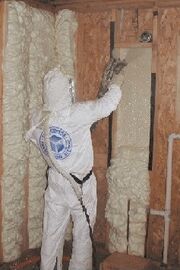
Spray-In Foam Insulation
Spray-in foam sealing is a different approach to energy loss and is becoming more popular in new home construction. The foam is generally made polyicynene or polyurethane although other variants exist.
Spray in foam is almost always professionally installed and is applied to the underside of your roof and completely seals the attic from any air leaks from the attic.
This approach is very energy efficient and substantially reduces the temperature of your attic in the summer and increases it in the winter as the temperatures more closely represent those that are in your living spaces. An additional benefit of spray in foam is that it is also a noise barrier.
Thermal Shield
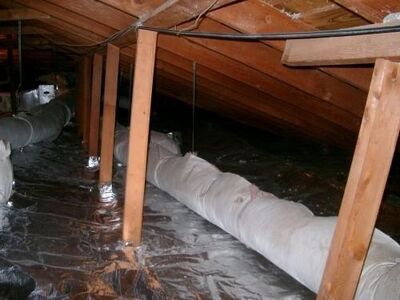
Radient Barrier Insulation
A thermal shield is also a reasonably new method of insulation. A thermal shield is a thin layer (looks like tin foil) that reflects radiant heat escaping from your living areas back into them instead of letting it escape into the attic. When installed in the attic, it can be either laid on top of the rafters, or applied to the underside of the attic roof or a combination of both.
Energy Efficient Window Film
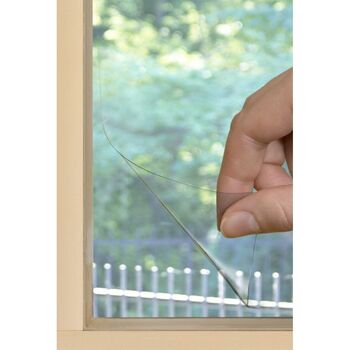
Energy Efficient Window Film
The U.S. Dept. of Energy estimates that during the summer up to 60% of a home’s cooling energy is lost through its windows and during the winter up to 25% of a home’s heating energy is lost through its windows.
If you have very old single pane or leaky widows the best option is to replace them. However, if you have window that aren't leaky, their energy performance can be substantially improved by adding energy efficient window film.
This film allows most visible light to pass through (usually around 80%), they blocking almost all (usually close around 98%) of harmful ultraviolet light from entering the house, and they block most infrared solar heat from penetrating the window. This means that in the summer about 70% of solar heat is prevented from entering your house and in the winter, about 40% of heat is prevented from escaping to the outside through your windows. There are many manufacturers of these products and you can dial the performance you'd like to certain level.
Energy efficient window films can be installed professionally or they can be a do-it-yourself project.
Fixing or Replacing Leaky Air Ducts
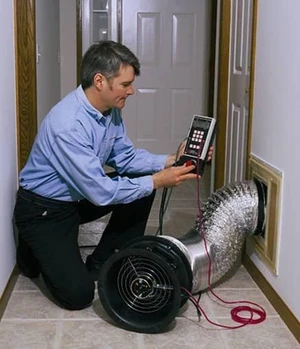
Duct Testing
This should be a big area of focus for older houses with forced air heating and/or cooling. The problem is, that over time, the duct system that carries the hot or cool air develops leaks and becomes inefficient. Since the ducts typically run through the attic, or in the basement or under-house crawl space, the leaks mean heat or cool is lost to non-living spaces. With an older house or in a house where ducts could have been damaged, leakage could range up to 50% or more which is a huge loss of energy efficiency and money waste.
Unfortunately, it is not easy to determine your self if you have leaky ducts. The only way to be sure is to hire a professional heating/cooling expert that is setup with the equipment to do a thorough duct test. To do this, all of the vents where heating or cooling enters your living spaces are blocked (with tape or temporarily installed coverings) and then a blower is applied to the ducts to pressurize the duct system and then leakage is measured with a professional tool.
If it is determined that your ducts are leaky, they can either be fixed by replacing sections or sealing them with spray-on sealant or the duct system could be completely replaced.
